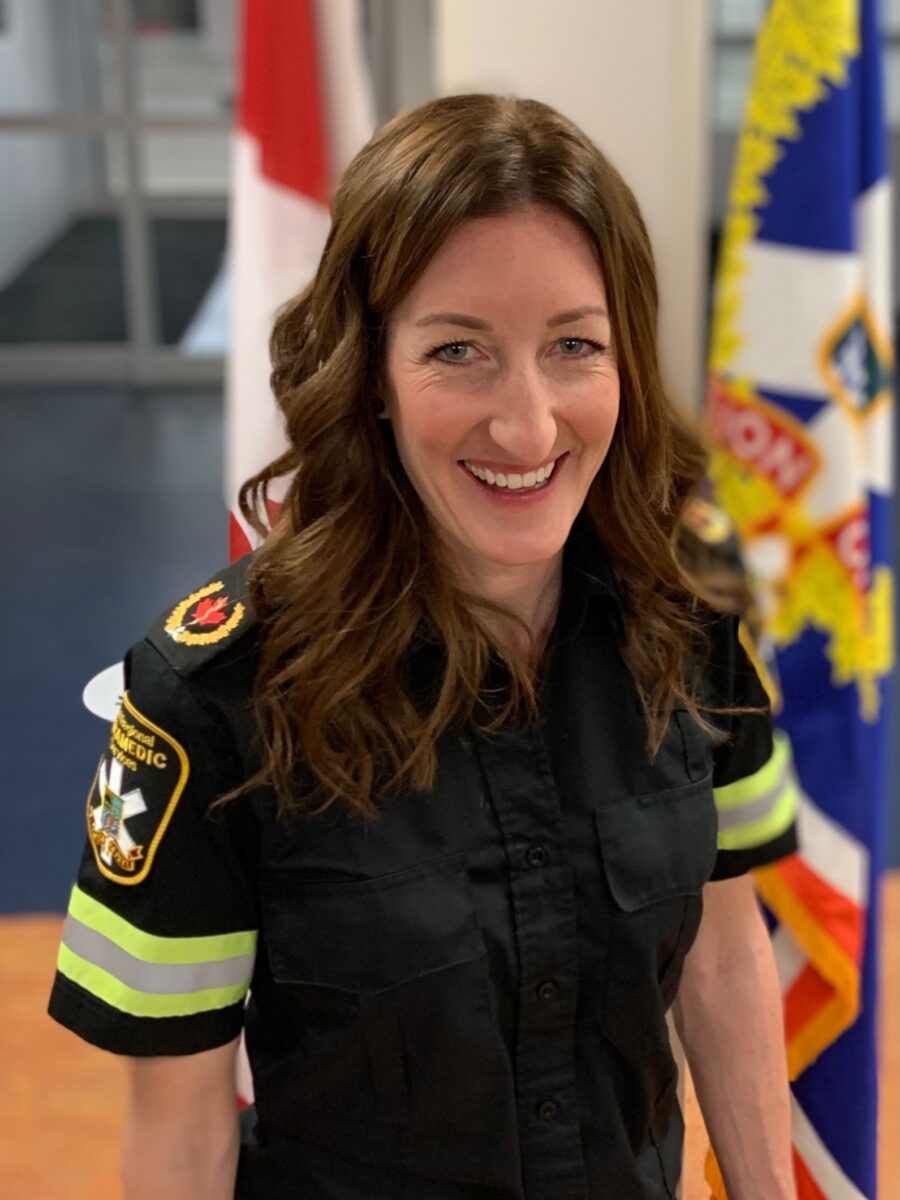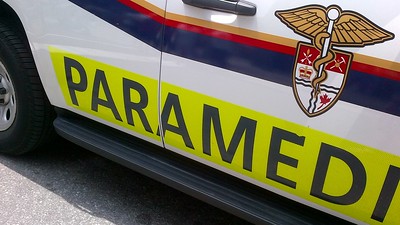Time stood still for Brampton-area paramedic Mandy Johnston as a patient tried to strangle her work partner.
They had sped to the scene with a brief summary from the 9-1-1 dispatcher. When they arrived at the property, they were met by a man at the end of the driveway, hurling threats at them.
They were trying to de-escalate the situation when suddenly the man wrapped his hands around Johnston’s partner’s neck, choking him.
Johnston froze. It wasn’t her first encounter with violence as a member of the Peel Regional Paramedic Service, but she recalls it being the first time that, for an outstretched moment, she didn’t know what to do.
After a few seconds, she snapped out of it and managed to break the men apart.
In that moment, she knew something had to change.
Threats, kicks, punches, sexual assault — these are all in a day’s work for paramedics, and observers say the rate of violence may be rising.

“There was a point in everyone’s life where this was completely abnormal,” said Johnston. “You would have never thought that you would accept verbal abuse, sexual harassment, intimidation and threats.”
Most of her colleagues at the Peel paramedic service at the time said they had experienced violence, but hadn’t documented it or reported it to anyone, she said.
When she asked why not, they would say that they had tried, and were told it was just part of the job, she said.
A paramedic serving the Peel region was physically assaulted every 46 hours, usually by patients, according to a 2023 study by Johnston and Justin Mausz, a paramedic and researcher at the Peel service.
Verbal harassment and threats were the most common forms of violence, followed by physical assaults — including spitting, kicking, shoving, hitting, or biting — and sexual assaults, the study found.
Anecdotal evidence suggests experiences of violence are also commonplace across the country for Canada’s 40,000 paramedics.
But there is minimal research on the issue. The most large-scale study dates back to 2014 and covers only Ontario and Nova Scotia. Results showed that 75 per cent of paramedics reported violent encounters at work, with 74 per cent reporting multiple types of violence, according to the study, which was published in the Prehospital Emergency Care journal.
Now researchers and paramedics are taking action to bring violence against emergency workers out of the shadows, and to provide better protection and support for them.
‘There was a point in everyone’s life where this was completely abnormal. You would have never thought that you would accept verbal abuse, sexual harassment, intimidation and threats.’
— Mandy Johnston, paramedic, Peel Regional Paramedic Service
The first nationwide study on the issue was launched in April as a joint project by the Paramedic Chiefs of Canada and researchers with Wilfrid Laurier University. Funded by the Centre for Security Science, a branch of the federal Department of National Defence, the study will include a nationwide survey and personal interviews with paramedics and their families to reveal the scope of the issue. Results are expected to roll out by March 2026.
Alexandra Hendriks, who also works for the Peel service, said paramedics have been accepting violence as part of the job for far too long.
She first heard about the risk while in college to become a paramedic. She was startled as she overheard two of her instructors swapping stories about being threatened with knives.
“What shocked me was how nonchalant they were about it,” said Hendriks. “It was casual for them.”
Hired at 19, Hendriks faced violence on the job herself, just three months into her career. She was sexually assaulted by a patient in the back of the ambulance, left speechless with hurt and shock as she proceeded to deliver the perpetrator to the hospital.
When she briefly mentioned what happened to hospital staff after transferring the patient, she was confused by their indifference, she recalled.
“It was kind of brushed off,” she said. “It was kind of . . . implied that as a young, female paramedic, I’d better get used to it.”
Two years later, in 2019, the Peel service launched a Violence in Paramedicine Research Group, led by Mausz and Elizabeth Donnelly, a former EMT and a professor of social work at the University of Windsor, in collaboration with the Montreal area’s Urgences-Santé, the University of Toronto and Queen’s University. The project seeks to gather the necessary data to mitigate the risk of violence against paramedics, while supporting those who have been affected.
‘It was kind of brushed off. It was kind of . . . implied that as a young, female paramedic, I’d better get used to it.’
— Alexandra Hendriks, paramedic, Peel Regional Paramedic Service
Their 2024 study found that one in four reported violent encounters in the Peel region were linked to a paramedic’s identity.
The most common identity-related attacks were incidents of misogynistic harassment — the use of demeaning language, sexual threats and exposing genitals to female paramedics. Another frequent complaint involved patients completely ignoring female paramedics.
Racist language was second most prevalent, including anti-Black and anti-Asian slurs or derogatory generalizations about racialized people.
Homophobic slurs and dehumanizing remarks with homophobic connotations were also reported multiple times.
Forms of aggression that targeted gender, race and sexual orientation were more likely to cause instant emotional distress among victimized paramedics than other forms of violence, the study found.
Without national statistics, there is no clear picture telling why paramedics encounter violence so often, or why the incidence of aggression appears to have risen in recent years, according to anecdotal reports from some paramedics and chiefs.

One theory is that lasting tension from the COVID-19 pandemic has contributed to the rise. Misinformation, fear and mistrust can all spread during prolonged public health crises, a 2023 report by Public Health Ontario noted.
During the 2022 trucker convoy occupation of downtown Ottawa, two ambulances were pelted with rocks, while a young paramedic was taunted with racial slurs as he checked for damage. Paramedics subsequently requested police escorts to protest areas until the end of the occupation.
Marc-Andre Periard, vice-president of the Paramedic Chiefs of Canada, says these tensions have persisted. “People are less patient, more vocal, and quicker to be negative to all first responders.”
Ashna Ganeshan, a paramedic for Leeds and Grenville county in Eastern Ontario, says some patients seem to fear paramedics, associating them with police. “Very often, I hear: ‘You guys are trying to take me to jail!’ and I have to reassure them that I’m trying to keep their health in check . . . not accuse them of a crime.”
Escalated by the pandemic, the ongoing mental health crisis in Canada has also overwhelmed healthcare workers. Suicidal behaviours and opioid-related deaths doubled one year into the pandemic, and these numbers remain higher than in pre-pandemic years, according to Health Canada.
“The healthcare system is in crisis, (and) individuals in the community are in crisis more so than they would have been a few years ago,” said Renée MacPhee, health sciences professor at Wilfrid Laurier and co-researcher for the upcoming national survey. “Many people with mental health problems are now experiencing more serious crises because they couldn’t get the care that they needed during (the pandemic).”
‘Very often, I hear: ‘You guys are trying to take me to jail!’ And I have to reassure them that I’m trying to keep their health in check . . . not accuse them of a crime.’
— Ashna Ganeshan, paramedic, United Counties of Leeds and Grenville
Over half of reported workplace assaults at the Peel paramedic service occurred on addiction- and/or mental health-related calls, according to the 2023 study by Donnelly and Mausz.
Patients in a mental health crisis are more likely to experience violence than be violent, Donnelly said, but the combination of a patient’s social environment with the degree of escalation before help arrives can come with unique risks.
“We are seeing a foundational failure in providing appropriate services to those with (mental health) concerns,” Donnelly said. “They find themselves in crisis when they’re not receiving what they need, and there’s a cascading concern to paramedics.”
This problem came to a head last year in downtown Victoria, B.C., in the Pandora Avenue area, where nearly 100 unhoused people were living in encampments.
In July 2024, a paramedic on Pandora was flagged down to help a man having a seizure. The man — who suffers from behavioural issues due to brain injury, according to community support workers — punched and kicked the paramedic in the face. The altercation escalated, and when police intervened, a combative crowd of about 60 people swarmed them, with some threatening to kill the first responders.

The paramedic was treated in hospital, and the mayor called an emergency meeting, after which local fire and paramedic leaders announced that no fire and ambulance crews would answer calls to the area without a police escort. Community workers have voiced concerns that waiting longer for emergency care will cause more deaths.
Dilemmas like this underscore the urgent need for measures to better ensure paramedic safety.
“Paramedics in fear of their wellbeing can’t perform their duties,” Periard said. “Violence jeopardizes the quality of patient care.”
The threat to patient care doesn’t stop at longer wait times. Repeated violence and workplace stress can worsen the risk of long-term psychological illness among paramedics, leading to shortages of emergency workers due to medical leaves and resignations.
Eleven per cent of paramedics report symptoms of post-traumatic stress disorder, compared with one per cent of non-emergency workers internationally, according to a 2023 study in the Journal of Paramedic Practice.
Even verbal threats can provoke PTSD responses and worsen depression or anxiety if a person faces them repeatedly, the study says.
PTSD, depression and anxiety are often debilitating. Symptoms can intensify weeks, months or years after a traumatic experience. If untreated, trauma can cause panic attacks, energy depletion, suicidal behaviours and harmful coping strategies.
Mental health problems are taking a severe toll on paramedics, causing frequent medical leave requests. Data from the City of Winnipeg shows that paramedics tallied 14,730 hours in psychological claims in 2022.
Burnout is also contributing to a shortage of paramedics: the average paramedic career lasts about seven years in Canada, and only four per cent make it to retirement, according to the Canadian Union of Public Employees.
Canadian colleges are expected to train around 700 new paramedics every year, but the country needs an estimated 1,100-1,200 per year, according to CUPE.
“We need support in these systems because we all depend on them.”
— Justin Mausz, paramedic and researcher, Peel Region Paramedic Service
In 2023, Ottawa’s rates of ‘level zero,’ when no ambulances are available for emergency calls, doubled those of the previous record in 2021.
Mausz says burnout should be an urgent cause for concern. “We need support in these systems because we all depend on them.”
Breaking the silence in the workplace is a key first step, advocates say: “When you’ve tolerated or accepted something within your profession for decades, it’s difficult to believe it could suddenly be different,” Johnston said.
“I don’t think that acceptance of violence and great patient care exist together.”
Johnston never did accept it.
She poured her desire for change into Peel’s External Violence Against Paramedics (EVAP) program. Johnston built the program from the ground up in 2019, starting with surveying paramedics in the region and designing media awareness campaigns, enhanced reporting procedures and organizing zero tolerance policies to support paramedics before and after experiencing violence on the job.
With EVAP, Johnston also led the design and implementation of an external violence incident reporting tool (EVIR) to make it easier for paramedics to document violence on the job.
Attached to their standardized ambulance call reports, the EVIR tool asks whether the paramedic experienced violence, prompts a description and then suggests support options.
“There was no easy way to report violence before,” Hendriks said.
Reporting rates at Peel have since skyrocketed. Data from every report is used to inform change both at the workplace and at the municipal level. These have included zero tolerance policy signs in ambulances, and the development of specialized EVAP training for new paramedics.
“Paramedics are encouraged to report (incidents) because they’re not just helping themselves or their colleagues,” Johnston said. “They’re doing good for paramedics everywhere.”
Reporting also gives paramedics the opportunity to reflect on what happened to them. “They get to vent professionally, knowing someone’s going to hear them.”
Meanwhile, Ontario paramedic services and college programs now teach protective skills and threat evaluation and response tactics through advanced learning for evaluating and recognizing threats (ALERT) training programs. Peel’s EVAP team announced ALERT training in 2024, offering specialized learning through realistic scenarios.
‘We want to see this become an indictable offence . . . like if someone were to attack a police officer.’
— Katherine Hambleton, operations vice-president, Ontario Paramedic Association
Now an ALERT instructor, Hendriks says it is deeply rewarding to provide the support she wished she had years before. “I don’t want any new hires to feel the way I did.”
She says there has been a noticeable shift in paramedic work culture and that, finally, paramedics are no longer tolerating violence.
Canadian paramedic services in Ottawa, Toronto, and other cities are also adopting zero tolerance frameworks, equipping employees with protective gear such as spit hoods and soft restraints, and implementing ALERT programs.
Meanwhile, the ongoing national study on the issue will provide valuable insight into the problem, as well as potential responses. MacPhee says she also hopes results will unfreeze past efforts to change the criminal code to create harsher penalties for perpetrators of violence against healthcare workers, including paramedics.
Introduced at the height of the pandemic in Nov. 2021, Bill C-321 had made it to third reading in the Senate in December 2024, but died on the order paper when Parliament was prorogued ahead of the federal Liberal leadership contest and subsequent federal election.
Katherine Hambleton, operations vice-president for the Ontario Paramedic Association, says Bill C-321 is an important step to offering paramedics a sense of protection.
“We have a risk right now of having everything dissolved, all of that work over the years,” Hambleton said. “We want to see this become an indictable offence . . . like if someone were to attack a police officer.”
Periard agrees, saying: “We need to make sure the public is aware that it’s unacceptable to (assault paramedics). We call upon them in our time of need, and as leaders we need to make sure they have the safest and best work environment possible.”




